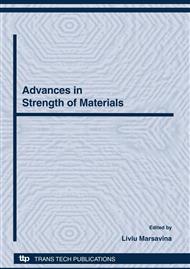p.51
p.63
p.71
p.79
p.89
p.97
p.105
p.113
p.123
The Effect of Geometry and Material Properties on the Load Capacity of Single-Strapped Adhesive Bonded Joints
Abstract:
Adhesive bonding is a particularly effective method of assembling complex structures, especially those made from dissimilar materials. If the joint is well designed and correctly executed, the adhesive bond ought to be one of the strongest components of the structure and most certainly should not be the reason for reducing the load capacity or fatigue life. The major factors determining the integrity of an adhesive bond are selection of the most appropriate adhesive, joint design, preparation of the bonding surfaces, strict quality control in production and monitoring in service. This work focuses on the evaluation of the load capacity of some configurations of adhesively bonded single-strapped joints based on finite element analyses. The adhesive layer thickness, the overlap length, the adherent and strap thicknesses were varied as well as the materials properties.
Info:
Periodical:
Pages:
89-96
Citation:
Online since:
October 2008
Price:
Сopyright:
© 2009 Trans Tech Publications Ltd. All Rights Reserved
Share:
Citation:


